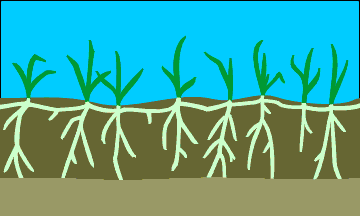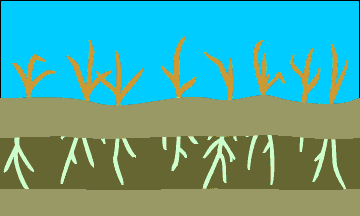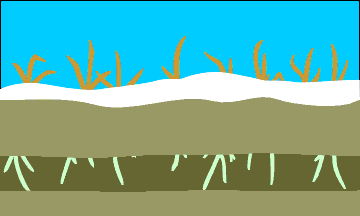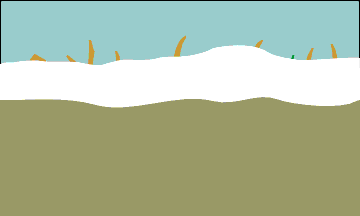Steps showing the thawing and freezing cycle:
Under the tundra in the northern part of the Arctic Refuge, the active layer begins to thaw
after the winter snows melt in early summer. Snow can fall in any month, but it doesn't usually
stay on the ground until September. What date do you think the active layer is melted deepest?
You may be surprized...
Here's how the active layer changes throughout the year (These dates are averages. The
actual dates on any year may be slightly earlier or later.):
 On May 15, the
tundra soil is still buried under winter snow, and the active layer is completely frozen.
On May 15, the
tundra soil is still buried under winter snow, and the active layer is completely frozen.
 By June 1, the snow has
begun to melt, but the active layer remains frozen.
By June 1, the snow has
begun to melt, but the active layer remains frozen.
 On June 15, the active
layer is already thawed half
way (50%) to its maximum depth. It is about 9 inches (23 cm) deep. The sun remains above the
horizon for 24 hours each day, and plants are producing new growth.
On June 15, the active
layer is already thawed half
way (50%) to its maximum depth. It is about 9 inches (23 cm) deep. The sun remains above the
horizon for 24 hours each day, and plants are producing new growth.
 By July 1, the active layer
has thawed to 75% of its total depth. It is about 13.5 inches (34.5 cm) deep.
By July 1, the active layer
has thawed to 75% of its total depth. It is about 13.5 inches (34.5 cm) deep.
 On July 15, the active layer
has thawed to 85% of its total depth. It is about 15 inches (38 cm) deep.
On July 15, the active layer
has thawed to 85% of its total depth. It is about 15 inches (38 cm) deep.
 On August 1, the active
layer has thawed to 90% of its total depth. It is about 16 inches (40.5 cm) deep.
On August 1, the active
layer has thawed to 90% of its total depth. It is about 16 inches (40.5 cm) deep.
 By August 15, the active
layer has thawed to 92%
of its total depth. It is about 16.5 inches (42 cm) deep. Autumn has come to the tundra. The air
is cooler, and plants are finishing their growth for the year.
By August 15, the active
layer has thawed to 92%
of its total depth. It is about 16.5 inches (42 cm) deep. Autumn has come to the tundra. The air
is cooler, and plants are finishing their growth for the year.
 On September 1, the active
layer has thawed to 94%
of its total depth. It is about 16.75 inches (42.5 cm) deep. Air temperatures are now below
freezing, and the soil surface begins to refreeze.
On September 1, the active
layer has thawed to 94%
of its total depth. It is about 16.75 inches (42.5 cm) deep. Air temperatures are now below
freezing, and the soil surface begins to refreeze.
 On September 15, the active
layer has thawed to
96% of its total depth. It is about 17.25 inches (43.25 cm) deep. The soil surface continues to
freeze down into the active layer.
On September 15, the active
layer has thawed to
96% of its total depth. It is about 17.25 inches (43.25 cm) deep. The soil surface continues to
freeze down into the active layer.
 By October 1, the
active layer has thawed to 98%
of its total depth. It is about 17.75 inches (44.5 cm) deep.
By October 1, the
active layer has thawed to 98%
of its total depth. It is about 17.75 inches (44.5 cm) deep.
 On October 15, the active
layer has thawed to its
maximum depth of 18 inches (about 45.5 cm). The soil above it is refreezing rapidly. Did you
guess that the active layer would reach its maximum depth in mid October?
On October 15, the active
layer has thawed to its
maximum depth of 18 inches (about 45.5 cm). The soil above it is refreezing rapidly. Did you
guess that the active layer would reach its maximum depth in mid October?
 By November 1, there is
just a narrow region above the base of the active layer that is not frozen.
By November 1, there is
just a narrow region above the base of the active layer that is not frozen.
 By November 15,
the active layer has completely frozen, and will remain this way until early summer.
By November 15,
the active layer has completely frozen, and will remain this way until early summer.
Return to top





